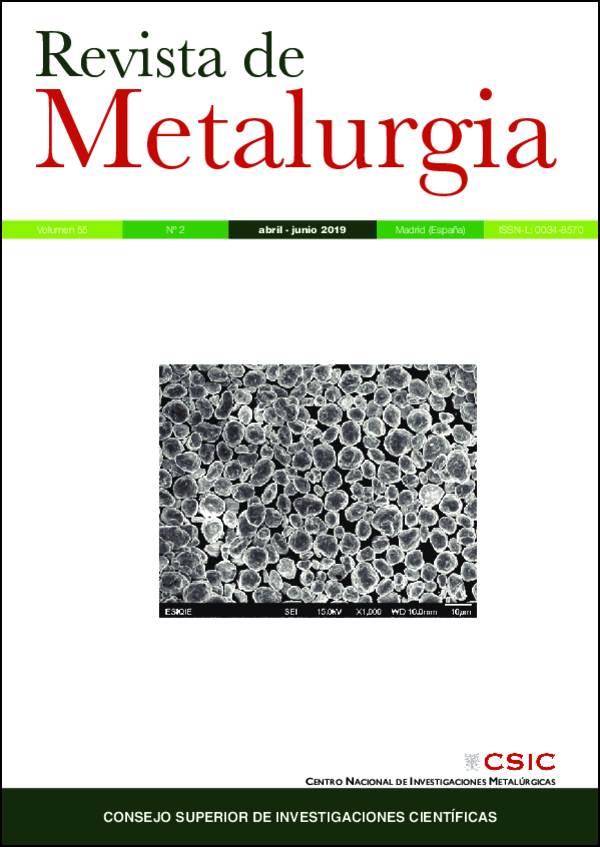Study on extraction of light rare earth from liquid - liquid extraction using organophosphoric acids extractants and ascorbic acid
DOI:
https://doi.org/10.3989/revmetalm.142Keywords:
Ascorbic acid, Cyanex272, D2EHPA, Rare earth elements, Liquid–liquid extraction, P507Abstract
The Liquid – liquid extraction (LLE) or solvent extraction (SX) is the most widely technique used to separate the Rare Earth Elements (REEs). The saponification of the extractants has been used as an efficient practice to promote this separation, however this process produces wastewater containing ammonia – nitrogen, sodium, magnesium or calcium ions that must be removed from solution otherwise could cause environmental pollution. There is a concern about separating efficiently rare earth elements by alternative methods to saponification. The use of complexing agents, such as ascorbic acid, may be used as an alternative to maintain the efficiency of the separation process and without causing any harm to the environment because it is a biodegradable substance. This study aimed to evaluate the influence of ascorbic acid concentration over lanthanum and didymium (Pr + Nd) extraction by liquid – liquid extraction. Three acids organophosphorus extractants were used (D2EHPA, P507 and Cyanex272). The experiments showed that, the increase in the ascorbic acid concentration enhances the extraction and selectivity of the extraction of REEs. It was also determined that the more efficient extractant in the conditions of this study was P507. We considered that the best conditions to perform the separation between La / didymium was obtained with P507 as extraction agent P507 and concentration of ascorbic acid 0.5 mol·L-1. In this condition the extractions of La, Pr and Nd were obtained equal to 12.3 ± 1.3%, 56.4 ± 1.0%, 64.8 ± 1.7%, respectively, as well as a separation factor of 9.3 ± 0.8 and didymium in organic phase with 81.4 ± 0.5% purity.
Downloads
References
AlMarzooqi, F.A., Al Ghaferi, A.A., Saadat, I., Hilal, N. (2014). Application of Capacitive Deionisation in water desalination: A review. Desalination 342, 3-15. https://doi.org/10.1016/j.desal.2014.02.031
Da Luz, A.B., Lins, F.F. (2005). Rochas & Minerais Industriais. Usos e Especificacões. Terras Raras. CETEM/MCT, Rio de Janeiro, pp. 629-654.
Eckenfelder, W.W. Jr, Cleary, J.G. (2013). Activated Sludge Technologies for Treating Industrial Wastewaters: Design and Troubleshooting. DEStech Publications Inc., Lancaster, Pennsylvania.
Gomes, R.C., Seruff, L.A, Scal, M.L.W., Vera, Y.M. (2017). The influence of lactic acid concentration on the separation of light rare earth elements by continuous liquid-liquid extraction with 2-ethylhexyl phosphonic acid mono-2-ethylhexyl ester. Metal. Mater. Trans. B 49 (1), 460-465. https://doi.org/10.1007/s11663-017-1124-4
Gupta, C.K., Krishnamurthy, N. (2005). Extractive Metallurgy of Rare Earth. CRC Press, Boca Raton, Florida. https://doi.org/10.1201/9780203413029
Hasegawa, Y., Sugawara, T., Choppin, G.R. (1988). Thermodynamic parameters of complexation of lanthanoid(II1) with ascorbic acid. Inorg. Chim. Acta 143 (2), 277-280. https://doi.org/10.1016/S0020-1693(00)83701-9
Martell, A.E., Smith. R.M. (1977). Critical Stability Constants, Other ligands. Vol. 3, Plenum Press, New York.
Nishihama S., Hirai T., Komaswa, I. (2000). Selective Extraction of Y from a Ho/Y/Er Mixture by Liquid-Liquid Extraction in the Presence of a Water-Soluble Complexing Agent. Ind. Eng. Chem. Res. 39 (10), 3907-3911. https://doi.org/10.1021/ie000030a
Pearson, R.G. (1963). Hard and soft acids and bases. J. Am. Chem. Soc. 85 (22), 3533-3539. https://doi.org/10.1021/ja00905a001
Pribil, R., Vesely, V. (1963). Contributions to the basic problems of Complexometry-XII. Successive determination of thorium, rare earths and some other elements. Talanta 10 (8), 899-903. https://doi.org/10.1016/0039-9140(63)80251-9
Ritcey, G.M. (2006). Solvent Extraction. Principles and Applications to Process Metallurgy. 2nd Edition, G.M. Ritcey & Associates Incorporated, Ottawa.
Scal, M.L.W., Seruff, L.A., Vera, Y.M. (2016). Didymium separation from lanthanum by solvent extraction using 2-ethylhexylphosphonic acid mono-2-ethylhexyl ester and lactic acid. Tecnol. Metal. Mater. Mine. 13, 373-380. https://doi.org/10.4322/2176-1523.1131
Wang, Y.G., Xiong, Y., Meng, S.L., Li, D.Q. (2004). Separation of yttrium from heavy lanthanide by CA-100 using the complexing agent. Talanta 63 (2), 239-243. https://doi.org/10.1016/j.talanta.2003.09.034 PMid:18969423
Yan, C., Jia, J., Liao, C., Wu, S., Xu, G. (2006). Rare Earth Separation in China. Tsinghua Sci. Technol. 11 (2), 241-247. https://doi.org/10.1016/S1007-0214(06)70183-3
Published
How to Cite
Issue
Section
License
Copyright (c) 2019 Consejo Superior de Investigaciones Científicas (CSIC)

This work is licensed under a Creative Commons Attribution 4.0 International License.
© CSIC. Manuscripts published in both the printed and online versions of this Journal are the property of Consejo Superior de Investigaciones Científicas, and quoting this source is a requirement for any partial or full reproduction.All contents of this electronic edition, except where otherwise noted, are distributed under a “Creative Commons Attribution 4.0 International” (CC BY 4.0) License. You may read here the basic information and the legal text of the license. The indication of the CC BY 4.0 License must be expressly stated in this way when necessary.
Self-archiving in repositories, personal webpages or similar, of any version other than the published by the Editor, is not allowed.
















